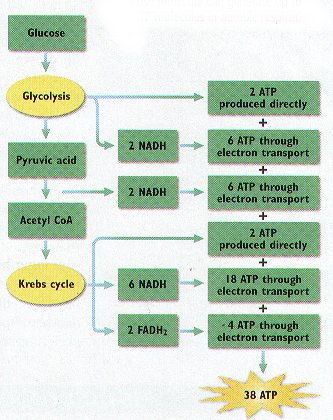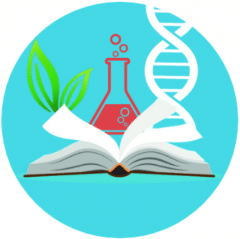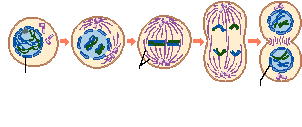| Cellular Respiration All Materials © Cmassengale |
C6H12O6 + 6O2 —–> 6CO2 + 6H20 + energy (heat and ATP)

Energy
- Capacity to move or change matter
- Forms of energy are important to life include Chemical, radiant (heat & light), mechanical, and electrical
- Energy can be transformed from one form to another
- Chemical energy is the energy contained in the chemical bonds of molecules
- Radiant energy travels in waves and is sometimes called electromagnetic energy. An example is visible light
- Photosynthesis converts light energy to chemical energy
- Energy that is stored is called potential energy
Laws of Thermodynamics
-
1st law- Energy cannot be created or destroyed.
Energy can be converted from one form to another. The sum of the energy before the conversion is equal to the sum of the energy after the conversion.
-
2nd law- Some usable energy is lost during transformations.
During changes from one form of energy to another, some usable energy is lost, usually as heat. The amount of usable energy therefore decreases.
Adenosine triphosphate (ATP)
- Energy carrying molecule used by cells to fuel their cellular processes
- ATP is composed of an adenine base, ribose sugar, & 3 phosphate (PO4) groups
 |
- The PO4 bonds are high-energy bonds that require energy to be made & release energy when broken
 |
- ATP is made & used continuously by cells
- Every minute all of an organism’s ATP is recycled
- Phosphorylation refers to the chemical reactions that make ATP by adding Pi to ADP ADP + Pi + energy « ATP + H2O
- Enzymes (ATP synthetase& ATPase) help break & reform these high energy PO4 bonds in a process called substrate-level phosphorylation
- When the high-energy phosphate bond is broken, it releases energy, a free phosphate group, & adenosine diphosphate (ADP)
 |
Enzymes in Metabolic Pathways:
- Biological catalysts
- Speeds up chemical reactions
- Lowers the amount of activation energy needed by weakening existing bonds in substrates

- Highly specific protein molecules
- Have an area called the active site where substrates temporarily join

- Form an enzyme-substrate complex to stress bonds
- Enzyme usable
enzyme substrate complex

NADH: A second energy carrying molecule in the mitochondria; produces 3 ATP
![]()
 |
FADH2: A third energy carrying molecule in the mitochondria; produces 2 ATP
 |
Mitochondria:
- Has outer smooth, outer membrane & folded inner membrane
- Folds are called cristae
- Space inside cristae is called the matrix & contains DNA & ribosomes
- Site of aerobic respiration
- Krebs cycle takes place in matrix
- Electron Transport Chain takes place in cristae

Cellular Respiration Overview:
C6H12O6 + 6O2 —–> 6CO2 + 6H20 + energy (heat and ATP)
- Controlled release of energy from organic molecules (most often glucose)
- Glucose is oxidized (loses e-) & oxygen is reduced (gains e-)
- The carbon atoms of glucose (C6H12O6) are released as CO2
- Generates ATP (adenosine triphosphate)
 |
- The energy in one glucose molecule may be used to produce 36 ATP
- Involves a series of 3 reactions — Glycolysis, Kreb’s Cycle, & Electron Transport Chain
Glycolysis:
- Occurs in the cytoplasm
- Summary of the steps of Glycolysis:
a. 2 ATP added to glucose (6C) to energize it.
b. Glucose split to 2 PGAL (3C). (PGAL = phosphoglyceraldehyde)
c. H+ and e- (e- = electron) taken from each PGAL & given to make 2 NADH.
d. NADH is energy and e- carrier.
e. Each PGAL rearranged into pyruvate (3C), with energy transferred to make 4 ATP (substrate phosphorylation).
f. Although glycolysis makes 4 ATP, the net ATP production by this step is 2 ATP (because 2 ATP were used to start glycolysis). The 2 net ATP are available for cell use.
g. If oxygen is available to the cell, the pyruvate will move into the mitochondria & aerobic respiration will begin.


Net Yield from Glycolysis 4 NADH2 2 CO2 4 ATP ( 2 used to start reaction)
h. If no oxygen is available to the cell (anaerobic), the pyruvate will be fermented by addition of 2 H from the NADH (to alcohol + CO2 in yeast or lactic acid in muscle cells). This changes NADH back to NAD+ so it is available for step c above. This keeps glycolysis going!
| Alcoholic Fermentation |
 |
| Lactic Acid Fermentation |
 |
Aerobic Respiration:
- Occurs in the mitochondria
- Includes the Krebs Cycle & the Electron Transport Chain
- Pyruvic acid from glycolysis diffuses into matrix of mitochondria & reacts with coenzyme A to for acetyl-CoA (2-carbon compound)
- CO2 and NADH are also produced

Kreb’s Cycle:
- Named for biochemist Hans Krebs
- Metabolic pathway that indirectly requires O2
- Kreb’s Cycle is also known as the Citric acid Cycle
- Requires 2 cycles to metabolize glucose
- Acetyl Co-A (2C) enters the Kreb’s Cycle & joins with Oxaloacetic Acid (4C) to make Citric Acid (6C)
- Citric acid is oxidized releasing CO2 , free H+, & e- and forming ketoglutaric acid (5C)
- Free e- reduce the energy carriers NAD+ to NADH2 and FAD+ to FADH2
- Ketoglutaric acid is also oxidized releasing more CO2 , free H+, & e-
- The cycle continues oxidizing the carbon compounds formed (succinic acid, fumaric acid, malic acid, etc.) producing more CO2, NADH2, FADH2, & ATP
- H2O is added to supply more H+
- CO2 is a waste product that diffuses out of cells
- Oxaloacetic acid is regenerated to start the cycle again
- NADH2 and FADH2 produced migrate to the Electron Transport Chain (ETC)

| Net Yield from Kreb’s Cycle (2 turns) |
| 6 NADH2 |
| 2 FADH2 |
| 4 CO2 |
| 2 ATP |
Electron Transport Chain:
- Found in the inner mitochondrial membrane or cristae
- Contains 4 protein-based complexes that work in sequence moving H+ from the matrix across the inner membrane (proton pumps)
- A concentration gradient of H+ between the inner & outer mitochondrial membrane occurs
- H+ concentration gradient causes the synthesis of ATP by chemiosmosis
- Energized e- & H+ from the 10 NADH2 and 2 FADH2 (produced during glycolysis & Krebs cycle) are transferred to O2 to produce H2O (redox reaction)
O2 + 4e- + 4H+ 2H2O

| Energy Yield from Aerobic Respiration | ||
| Glycolysis | Kreb’s Cycle | Total |
| 4 NADH2 | 6 NADH2 | 10 NADH2 x 3 = 30 ATP |
| 0 FADH2 | 2 FADH2 | 2 FADH2 x 2 = 4 ATP |
| 2 ATP | 2 ATP | 4 ATP |
| 38 ATP | ||
- Most cells produce 36- 38 molecules of ATP per glucose (66% efficient)
- Actual number of ATP’s produced by aerobic respiration varies among cells














